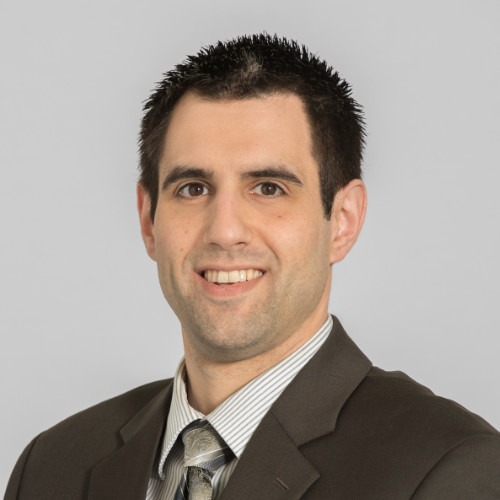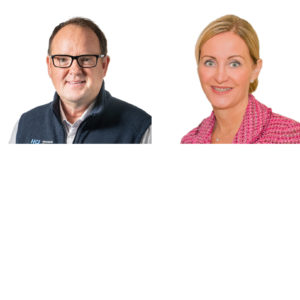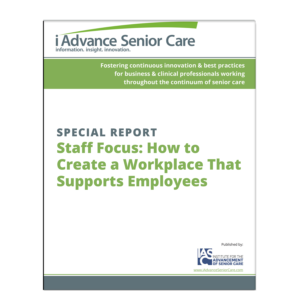Mather Pavilion’s Culture of Leadership
Since 1996, Long-Term Living has been honoring long-term care facilities that are proactive with programs that go “above and beyond” routine care for their residents with our prestigious OPTIMA Award. It is conferred by a jury of your long-term care peers from submitted entries. This year's winner is Mather Pavilion of Evanston, Illinois-one of the four Mather LifeWays senior residences. As was the case for many communities a decade ago, severe turnover among nurses and especially CNAs forced Mather Pavilion's administration to review staff and resident satisfaction. Through focus groups and surveys, the community learned of the respondents' shared desires: respect, communication, and meaningful relationships. To meet these needs, the LEAP (Learn, Empower, Achieve, Produce) program was implemented in November of 2000. Nurses were trained to be leaders and clinical experts; CNAs were selected to advance in their positions through a career ladder. By developing an effective long-term care workforce that empowers individual staff members to lead or mentor colleagues, a dramatic reversal in staff turnover was realized, leading to improved quality of resident-centered care at this 150-bed community. Our congratulations to this year's winner for all the hard work, inspired ideas, and commitment to making a positive change every day in every elder's life. We'd also like to thank Direct Supply for sponsoring our 15th annual OPTIMA Award. |
|
The confidence that drives Mather Pavilion's CNAs like Garcia to engage in regular dialogue with families is the result of an inspiring workforce initiative called LEAP. It represents the goals “Learn, Empower, Achieve, Produce” and is the brainchild of a nonprofit skilled nursing community that, for a brief period, found itself wondering how to overcome the staffing blues.
Those who desired change
At the end of the ′90s, Mather Pavilion's turnover rates were at a high of 47% for nurses and 76% for CNAs. While this situation may have been common in long-term care at the time, administration and staff identified how such poor retention was affecting resident care. A consultant from the state affiliate of the American Association of Homes and Services for the Aging (AAHSA) was brought in to facilitate focus groups and provide an objective summary of staff, resident, and family comments about the community. Surveys had also been administered-the results of which were eye-opening: Nurses wanted more communication and support, along with feelings of appreciation; CNAs requested in-depth clinical skills, enabling them to better care for residents; and the residents themselves simply wanted relationships with their caregivers.
“The focus groups allowed everyone to be comfortable talking to someone they didn't know saying whatever was on their mind,” says Jayne Schaefer, workforce programs manager at Mather LifeWays. In-house researchers and educators partnered with the AAHSA consultant to design a comprehensive program that educates both nurses and CNAs within a consistent assignment staffing model. This form of staffing assigns specific caregivers to individual residents allowing meaningful relationships to be formed.
“Sometimes all they need is a hug, telling them that you love them and you care for them and you live for them,” Garcia says of her own residents.
While this resident-centered staffing model is popular within the culture change movement, addressing the actual needs of staff members demands a unique, strategic resolution. This is why LEAP was founded, Schaefer says, on the belief that staff training must be implemented at all levels of nursing in order to achieve the goals of retention, satisfaction, and increased quality of care.
So, how has the LEAP program fared in achieving these goals during its near decade of implementation? Mather Pavilion reports turnover has dropped consistently over the years, and since 2007, turnover rates for both nurses and CNAs hover at or below 10%. Resident and family satisfaction, meanwhile, is at 98% for 2010.
LEAP's Objectives1: Implement a comprehensive education program for the development of all nurse managers and staff nurses. OUTCOME: One hundred percent of targeted staff attended a series of six training workshops to develop leadership, care role modeling, and team-building skills while increasing clinical gerontological expertise. 2: Execute a career mobility ladder for the continued development and advancement of CNAs. OUTCOME: Twenty-six CNAs applied for the program and were interviewed, half of whom were selected to attend seven training workshops in preparation for expanded roles. 3: Evaluate the impact of LEAP by examining job turnover. OUTCOME: Nursing staff retention rates increased by 10% annually. 4: Develop a sustainable program to reduce staff turnover. OUTCOME: LEAP has existed for nine years while achieving its goal of dramatically reducing turnover rates among nurses and CNAs. 5: Increase resident satisfaction. OUTCOME: Since its introduction, the LEAP program has coincided with resident satisfaction levels between 95-100%. |
Cultivating leaders
There are several ambitious components of the LEAP program that guide its effectiveness. Aside from the resident-centered approach, Mather Pavilion employs teaching methods based on adult learning theory; tracks LEAP's progress through research-based evaluation mechanisms that target staff and resident outcomes; and trains staff through workshops to encourage culture change within the community. And it is this training, the program team says, that gives LEAP its teeth.
First was the implementation of six training workshops for the nursing staff, which all nurse managers and staff nurses attended. Each session lasts three hours and focuses on the development of leadership roles, gerontological clinical expertise, and care team building. The sessions also include realistic scenarios where action steps can be role-played.
To meet the best interests of CNAs, communities often provide tuition reimbursement, allowing these individuals to advance to licensed practical nurse or registered nurse careers. However, Mather Pavilion's CNAs told administration they did not necessarily aspire to become nurses. What they wanted, according to the focus group and survey results, was a team environment for providing superb resident care.
Nurse Training
|
In response, Mather Pavilion created a career ladder for CNAs that allows them to continue the work they enjoy, yet also advance their clinical knowledge. First is the Level 1 CNA, coined as “basic.” The advanced Level 2 CNA has, aside from greater clinical education, the added responsibility of being a mentor to new CNAs.
Pearl McDonald, a licensed practical nurse at Mather Pavilion, witnesses these mentors instill a precious sense of assurance within all newcomers. “You're saying, ‘I have confidence in you to do this job,’” Pearl insists. “Who's going to fail when you have that much confidence in a person? And when they take care of their people, they let you know exactly what's going on.”
Aside from the difference in curriculum, CNA training varies from nurse training in that not everyone is eligible. When the CNA career ladder was introduced, a letter describing its requirements went into all paychecks and informative posters were displayed in break rooms. Candidates must be in good standing and possess at least one year of experience, and they must have demonstrated skills in leadership, dependability, clinical care, and teamwork. They are also asked to submit a formal written application, present a letter of recommendation from a nurse, and undergo an interview with the Director of Nursing (DON) and other management personnel.
Of the 26 CNAs who originally applied, 13 were selected to attend training workshops. These consist of seven sessions lasting two and a half hours each touching on care practices, communication skills, and clinical updates among other topics. Both basic (Level 1) and advanced (Level 2) CNAs attend these sessions, with the advanced group learning peer mentorship as well.
Raclyn Cauinian, DON of Mather Pavilion, attests that the disconnect usually experienced in long-term care communities between nurses and CNAs is absent because of LEAP's team-oriented training. “The nurses lead by example,” she says. “There is teamwork on every unit.” And in terms of the opportunity for career advancement, Cauinian is a walking archetype: 13 years ago she started as a supervisor, has worked as a staff floor nurse, and was eventually named assistant DON before her current directorial role.
CNA Training
|
Maintain an award-winner
|
Mather LifeWays is spreading the LEAP way of culture change. Linda Hollinger-Smith, PhD, RN, FAAN, vice president of research at Mather LifeWays Institute on Aging, says the program was originally pilot-tested in three additional long-term care communities in the Chicagoland area. Since then, Mather LifeWays received a five-year, $673,000 federal grant to test LEAP nationwide in more than 100 organizations. As co-author of the program, Hollinger-Smith says LEAP's inherent goals resonate with other providers, and the program is constructed to appeal to different learning styles. She and LEAP co-author Anna Ortigara, MS, RN, FAAN (currently working with NCB Capital Impact), are faculty at Rush University-positions that made both of them cognizant of how people prefer to learn.
However applicable the program may be to other organizations, LEAP training might be viewed as resource intense. Hollinger-Smith says preparing staff requires “a lot of upfront time, effort, staff hours. And the program itself is a ‘train the trainer’ program.” Beyond the two-day workshops that representatives attend, it's at least another 13 hours of training for staff back at the community. This is a lot of valuable time to set aside. “When we talk to organizations implementing LEAP, they understand that up front-that it's a culture change,” she emphasizes. “We're not there to do a couple hours training and then go.”
Still, LEAP's benefits continue to outweigh any strain on resources, Hollinger-Smith assures. The program is also regularly evaluated to ensure the goals of retention and quality care improvement are being met, and that it is current with what changes are occurring in the long-term care field. Its applicability in senior living is presently being tested as well.
Going on 10 years strong, LEAP has proven to be not only a sustainable workforce initiative, but a palpable caregiving creed. Schaefer tells of a visitor-the daughter of a former resident who passed away some years ago-volunteering her time to the community every Sunday. “Last week, I saw her serving ice cream. She told me that even though her mother had died, she'd been so moved by the spirit that was here she felt compelled to come back,” Schaefer says. It's the same spirit that makes Schaefer laugh with pride when staff speaks of sprinting toward the families. Just look at how far they've come.
Staff Retention
|
Long-Term Living 2010 September;59(9):20-24

Kevin Kolus wrote for I Advance Senior Care / Long-Term Living when he was an editor. He left the brand in 2012. He is now senior communications manager at Cleveland Clinic.
Related Articles
Topics: Articles , Staffing











